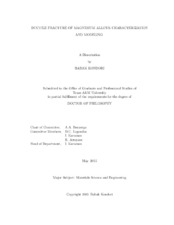| dc.contributor.advisor | Benzerga, Amine A | |
| dc.creator | Kondori, Babak | |
| dc.date.accessioned | 2015-09-21T16:55:05Z | |
| dc.date.available | 2017-05-01T05:35:51Z | |
| dc.date.created | 2015-05 | |
| dc.date.issued | 2015-04-02 | |
| dc.date.submitted | May 2015 | |
| dc.identifier.uri | https://hdl.handle.net/1969.1/155053 | |
| dc.description.abstract | Magnesium alloys are prime potential candidates for lightweight structural applications because of their superior specific stiffness and strength. However, their effective insertion in transportation vehicles hinges on improving their ductility and developing cost-effective forming technologies. Here, the processes of damage initiation and accumulation to fracture are investigated at ambient temperature, experimentally and theoretically, in two Mg alloys, AZ31 and WE43. Material AZ31 exhibits strong basal texture whereas WE43 has a weak non-basal texture with quasiisotropic properties. The microstructural characterization is carried out on the initial materials aiming at determining the texture, the grain size/shape distribution as well as the chemical composition, volume fraction, shape and spatial arrangement of second-phase particles. The macroscopic plastic flow anisotropy is characterized using round tensile bars and compression pins along three principal and three off-axes orientations. Semi-continuous measurement of diameter contraction in two orthogonal directions enabled the monitoring of relative volume change and strain-ratio evolution. The data is used to model the plastic anisotropy of the materials using models from the literature. A significant increase in volume is measured during plastic deformation. Macroscopic fracture loci, along two principal and one off-axis directions, are obtained for each material using round notched bars of varying notch acuity so as to study the effect of stress triaxiality and directionality on flow and fracture. It was found that notched AZ31 bars exhibit higher failure strain than uniaxial specimens. Second phase particles and deformation twins are identified as critical sites for damage initiation. Experiments also indicate that WE43 and AZ31 display significantly different sensitivities to stress triaxiality. Substantial drop in the failure strains of WE43 with increasing triaxiality is attributed to intergranular fracture. Image analysis is performed on specimens deformed to incipient and complete fracture to infer the distribution properties of voids and particles. A micromechanics-based continuum damage model is used to rationalize the main experimental trends and explore conflicting hypotheses. The model has two components: (i) a shape-dependent void growth; and (ii) a shape-dependent void/crack coalescence part. The results provide the groundwork for understanding the effects of microstructural and loading variables on damage and fracture in magnesium alloys. | en |
| dc.format.mimetype | application/pdf | |
| dc.language.iso | en | |
| dc.subject | Ductile Fracture | en |
| dc.subject | Magnesium | en |
| dc.title | Ductile Fracture of Magnesium Alloys: Characterization and Modeling | en |
| dc.type | Thesis | en |
| thesis.degree.department | Materials Science and Engineering | en |
| thesis.degree.discipline | Materials Science and Engineering | en |
| thesis.degree.grantor | Texas A & M University | en |
| thesis.degree.name | Doctor of Philosophy | en |
| thesis.degree.level | Doctoral | en |
| dc.contributor.committeeMember | Karaman, Ibrahim | |
| dc.contributor.committeeMember | Arróyave, Raymundo | |
| dc.contributor.committeeMember | Lagoudas, Dimitris C | |
| dc.type.material | text | en |
| dc.date.updated | 2015-09-21T16:55:05Z | |
| local.embargo.terms | 2017-05-01 | |
| local.etdauthor.orcid | 0000-0003-0810-6486 | |


